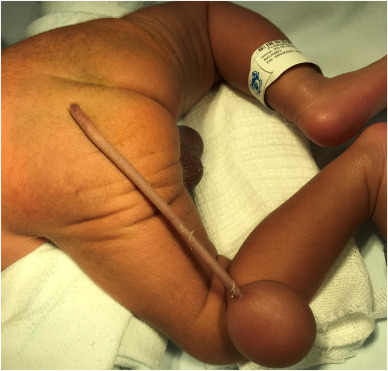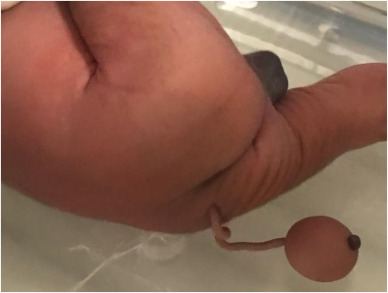
Journal of Pediatric Surgery Case Reports Photos of the Brazilian baby born with a tail
A Brazilian baby was born with a tail. Photos of the human tail were published in a journal article. You can see some of the photos in this article, but be aware that some might find them disturbing.
The report came from a journal article in Science Direct, which published photos of the baby’s tail. The headline in the March, 2021, article read, “A true human tail in neonate.” The article was first published in the Journal of Pediatric Surgery Case Reports.
The article explains, “Human tails are rare congenital anomalies and describe protrusions located around the midline of the lumbosacral region covered by skin, representing an embryonic trace. These lumbosacral skin appendages are often associated with hidden spinal dysraphism and other malformations such as lipoma and anchored cord syndrome.”
Be forewarned that the tail photos are graphics and may disturb some.
Here’s what you need to know:
The Baby’s Tail Was Surgically Removed

Journal of Pediatric Surgery Case ReportsThe Brazilian baby’s human tail
The baby was described in the article as “a newborn male, 35 weeks old, with a real human tail.” According to Tribune India, the baby was born in Brazil in the city of Fortaleza and the tail had a “ball” at the end of it.
Here’s another photo of the tail.

Journal of Pediatric Surgery Case ReportsThe human tail
The article, which contains pictures, says, “Initial assessment of the newborn revealed Kramer’s level III jaundice, a single umbilical artery and the presence of a rounded fibroelastic appendage of approximately 4 cm in its largest diameter, supported by a 12 cm fibrous cord in the left paravertebral lumbosacral region.”
Photos show that the tail was successfully removed. The article was published in the Journal of Pediatric Surgery Case Reports.
Human Tails Are ‘Rare Entities,’ the Article Says

Human tails are rare, but they do occur. What are they?
“Lumbosacral appendages, or human tails, are rare entities and represent the remnant of an embryonic vestige. They have been reported since the end of the 19th century, being generally small in size and located around the midline and lumbosacral region,” the article reports.
What is the treatment?
“Treatment for human tails should be done with surgical resection of the appendix, based on clinical and radiological examinations, especially the study of MRI,” it says.
It’s an anomaly that is not common.
“The presence of a true human tail in neonates is a rare congenital anomaly and should be investigated through physical and radiological examinations in a comprehensive manner. Due to the common ectodermal origin between the skin and the central nervous system, it is essential that the pediatrician or pediatric surgeon investigate the presence of hidden spinal dysraphism in patients with suspected skin lesions, as they may be the only visible abnormality and early diagnosis can prevent evolution to severe neurological changes,” the article explains.
The researchers did not obtain permission to review the case file. What kind of tissue is present in a human tail? “The real ones represent the persistence of a remnant of the embryonic tail formed between the fourth and eighth week of gestation, being composed of adipose and connective tissue, blood vessels, muscle and nerve fibers,” the researchers explained.
READ NEXT: Radio Exec ‘Paddy Duke’ Fired After Past Accusations Of Murder Exposed